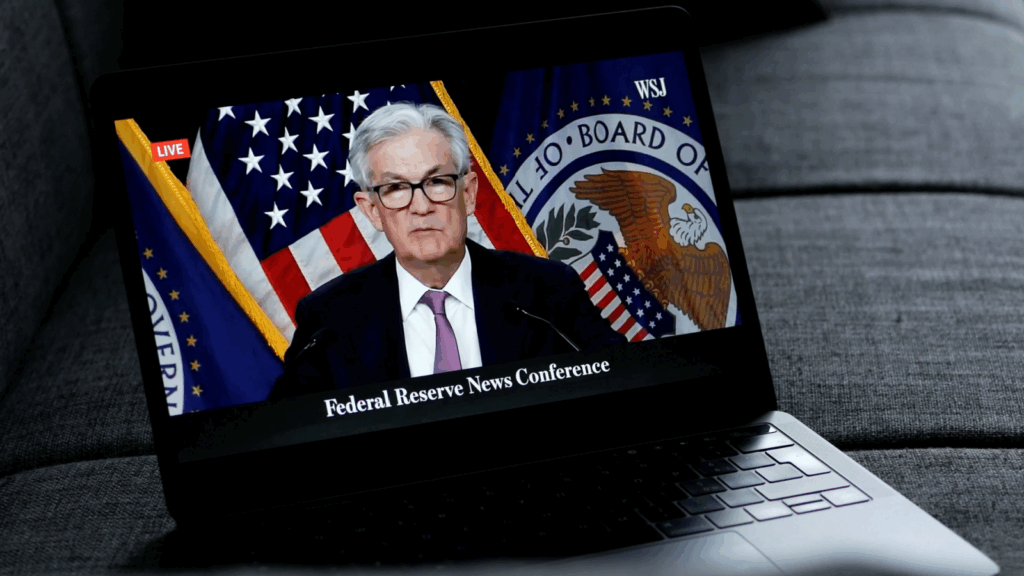What You’ll Hear From Powell at Jackson Hole
A Jackson Hole preview… what Louis Navellier and Luke Lango believe… do we need to worry about consumer sentiment?… a small tweak to help your returns… we’re nearing last call
VIEW IN BROWSER
The Fed is stuck between a bit of a rock and a hard place.
So wrote legendary investor Louis Navellier in last Friday’s Growth Investor Weekly update.
At the heart of this bind is the Federal Reserve’s dual mandate – maximum employment and stable prices. Both goals show signs of deterioration.
The challenge is that the Fed’s cure for one side of the mandate worsens the illness on the other.
So, which side gets the Fed’s lifeline?
As a quick recap, the July jobs report showed non-farm payrolls rising merely 73,000 – far below expectations. Meanwhile, the unemployment rate crept up to 4.2%, a sign that the labor market may be losing steam.
Then last Friday brought troubling sentiment data. Here’s our hypergrowth expert Luke Lango explaining:
The August University of Michigan Consumer Sentiment survey was… well, bad.
The sentiment data was the real gut-punch: overall consumer sentiment dropped from 61.7 in July to 58.6 in August (economists had expected an uptick) …
And views on the job market slid to their worst level since 2008.
Turning to inflation, last week brought alarming data from the red-hot Producer Price Index (PPI) report.
Here’s Louis with the quick summation:
The Producer Price Index (PPI) came in much hotter than anticipated.
Headline PPI rose 0.9% in July, compared to estimates of 0.2%… On a yearly basis, headline PPI is now up 3.3%, and core PPI is up 2.8%.
The jump in PPI in July ignited some fears that companies will need to pass off rising costs to consumers. In other words, folks are concerned that consumer prices will start to rise in the coming months.
So, how will the Fed try to thread this needle?
That’s what Wall Street is trying to answer – and why all eyes are on Fed Chair Jay Powell and the Jackson Hole Economic Symposium this Friday.
What to expect from Jackson Hole
During Powell’s speech on Friday, investors will be listening for clues about the Fed’s rate cut plans – specifically, for the September meeting.
In the wake of the weak jobs report, the expectation for a September cut hit 100% – and some market participants, like Louis, said a 50-basis-point cut was on the table.
But after last week’s PPI inflation data, expectations are falling. According to the CME Group’s FedWatch Tool, the odds of a 50-basis-point cut have dropped to zero, and that 100% rate-cut conviction is down to 83%.
So, what will Powell say?
Given that there won’t be an explicit pre-commit to a rate cut, we’ll be listening for language indicating that he’s skewing in one direction when he discusses the balance of risks.
To that end, when Powell references the labor market, if he talks about a return to more “normal” conditions rather than emphasizing a “weakening” trend, it might signal a greater degree of comfort with the current environment. Translation – no cut.
On inflation, we’re listening for Powell’s characterization of inflation as “one time pass-through” or persistent. The more he references the perspective of Fed governors Waller and Bowman (that inflation is pass-through), the greater the likelihood of a September cut.
Also important is how Powell speaks about the degree of “unknowns” ahead that could impact inflation.
Regardless of what Powell says, nothing is certain. Remember, according to the Dot Plot from the FOMC’s June meeting, seven of the 19 meeting participants expected no rate cuts for the remainder of 2025. However, recent discussions and the Waller/Bowman dissenting votes show that things could evolve more quickly than expected.
As for Louis, he’s predicting a cut:
There is a growing minority of FOMC members that want to cut key interest rates – and I suspect that will soon be a majority.
So, a September rate cut is growing more and more likely, and once the Fed finally slashes key interest rates, it should serve as a “turbo boost” to the stock market.
Luke is in the same camp.
In his recent Innovation Investor Daily Notes, after explaining why last week’s PPI data didn’t scare him, and why we shouldn’t place too much weight on consumer sentiment surveys, Luke concludes:
Step back and the macro picture hasn’t really changed:
- Inflation→ Still tame when you dig into the data.
- Rates→ Cuts are coming, likely starting in September.
- Economy→ Slower in spots, but far from recession territory.
- Market→ Healthy uptrend, with near-term volatility as just noise.
So, all eyes on Powell this Friday. We’ll report back.
Returning to last Friday’s poor Consumer Sentiment Survey…
Earlier, we highlighted how the University of Michigan’s Consumer Sentiment survey showed that overall consumer sentiment dropped from 61.7 in July to 58.6 in August – something that Luke largely brushed off.
Let’s dig deeper into why Luke is downplaying the data:
Consumer sentiment is notoriously volatile — it’s the emotional teenager of macro data.
We’ve seen it swoon before without denting actual spending trends, which only tend to follow sentiment down when pessimism stays entrenched for months…
Consumer sentiment crashed in early 2025 and it has been generally rebounding ever since.
This drop was the first since April, following a steady rebound earlier in the year. That makes it look more like a one-off bad mood than the start of a new downtrend.
To Luke’s point, below is the chart of consumer sentiment from the University of Michigan. I’ve circled 2025 so you can see the crash/rebound Luke referenced.
Source: University of Michigan Consumer Sentiment data
Here’s Luke’s takeaway:
Unless the September numbers are bad, too, we wouldn’t make too much of this August report.
Don’t let a grumpy sentiment survey shake you out of position. This is noise — and smart investors know what to do with noise.
How to make more money in the market with one small tweak
Behavioral finance consistently shows that investors – and too often, their advisers – are too quick to sell winners and too slow to cut losers. This is a cognitive bias known as the disposition effect.
Yesterday, MarketWatch highlighted a pilot program by a French brokerage suggesting that this bias can be nudged into check.
In a recent experiment at BNP Paribas’s firm Portzamparc, advisers were no longer shown whether their clients’ holdings were sitting at a gain or a loss (clients still had access online).
Here’s MarketWatch:
The intervention’s premise was that if financial advisers amplify their clients’ disposition effect, removing their ability to observe acquisition prices would reduce this bias.
The results were interesting. Before the change, highly advised clients were 50% more likely to sell assets showing a paper gain than those with a loss.
Post-intervention, that dropped to just 20%, and the brokerage saw monthly returns rise by 0.2 percentage points. Over a year, that’s roughly 2.4% extra return, which could be significant money based on the size of your portfolio.
So, what’s the action step in your portfolio?
While you shouldn’t ignore returns, performance on any single day, or even over short stretches of time, shouldn’t be your focal point.
Instead, focus more on why you bought your position – e.g., “This is a 5-year growth play on Physical AI and robotics” – and revisit that thesis quarterly.
In your analysis, beyond earnings and revenue growth, look at margins, debt levels, and overall competitive position. Even if the data isn’t perfect, trends over time usually tell you whether a company is strengthening or weakening.
Meanwhile, for those stocks where you’re underwater, don’t fixate on the loss. Instead, ask “is this stock the best use of my capital today based on all I know?”
If the answer is “yes,” ignore the loss.
If the answer is “no,” sell and move into a stronger stock.
Remember, your long-term “north star” in all this is earnings. Short-term price fluctuations are usually noise.
This recalls Louis’ “Iron Law” of the stock market:
Stock price trends can diverge from earnings trends for a while, but over the long-term, if a company grows and grows the amount of cash it takes in, its share price is sure to head higher.
Circling back to our hypothetical above
A moment ago, I wrote:
Instead, focus more on why you bought your position – e.g., “This is a 5-year growth play on Physical AI and robotics” – and revisit that thesis quarterly.
This was intentional.
Physical AI/robotics is the next phase of the AI megatrend. That’s why Louis and Luke, along with Eric Fry, recently released their latest collaborative investment research package about how to position yourself today for the coming era of Physical AL.
Their Day Zero Portfolio holds the seven stocks they’ve identified as best-of-breed in AI-powered robotics, providing targeted exposure to the next wave of AI exponential progress.
Here’s their respective quick takes:
From Louis:
We’re at the beginning of an innovation revolution built on robotics, AI-powered factories, autonomous logistics and more.
It’s arguably the most transformational thing to happen to our society since the Industrial Revolution.
From Eric:
Thanks to AI, robots are now stepping off the screen and into the real world – and taking over physical tasks once reserved for humans.
This shift will reshape entire industries… It’s blindingly obvious that the world of the future will look little like the world today.
From Luke:
We’re in the middle of the most profound platform shift in human economic history.
All the growth in today’s economy is happening inside the AI ecosystem. Everything else is just noise.
Just a heads-up – several of their recommendations have already jumped double digits (in less than two weeks), and they’re pruning some of their older picks as AI continues to evolve and leadership within the AI sector shifts.
So, we’ll likely soon be taking down their research video along with the discussion of their favorite Physical AI leaders. So, if you’ve been meaning to watch, just a friendly notice that we’re winding down. For now, you can see it all right here.
We’ll end today with their latest collective update on their portfolio:
New innovations also have spillover effects on previous technologies, further compounding their value.
AI today, for instance, can be used to enhance older technologies such as cars (self-driving vehicles), PCs (AI PCs), and smartphones (personal assistants).
If Physical AI follows this same trajectory (and we believe it will), we could be looking at $20 trillion or more in value creation.
This isn’t just another boom. It’s a multiplier.
That’s why we want to encourage you to consider our latest seven picks in robotics, if you haven’t yet.
Have a good evening,
Jeff Remsburg
The post What You’ll Hear From Powell at Jackson Hole appeared first on InvestorPlace.






